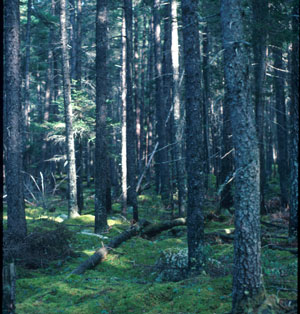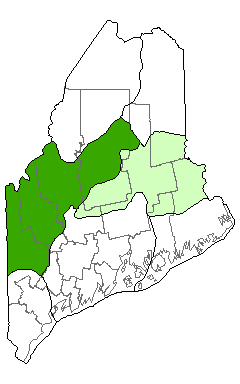DACF Home → Bureaus & Programs → Maine Natural Areas Program → Communities, Plants, and Animals → Natural Community Fact Sheets → Jack Pine Forest
Printer Friendly Fact Sheet - 950 KB pdf (Get a free copy of Adobe Acrobat Reader)
Jack Pine Forest
Scientific Name: Jack Pine Forest; State Rank: S1

- Community Description
- Soil and Site Characteristics
- Diagnostics
- Similar Types
- Conservation, Wildlife and Management Considerations
- Distribution
- Characteristic Plants
- Associated Rare Plants
- Associated Rare Animals
- Examples on Conservation Lands You Can Visit
Community Description: This closed canopy forest is dominated by jack pine. Black or red spruce and balsam fir are common associates (up to 20% cover and may be more common in the understory), and red pine may be mixed with jack pine in some areas. With the dense canopy, shrubs and herbs are limited in extent. Lowbush blueberry and boreal herbs such as bunchberry and Canada mayflower are typically present. The bryoid layer is very well developed, with an almost continuous carpet of feather-mosses in places. In these forests, jack pine requires natural or human-caused disturbance to stimulate seed germination, and hence to regenerate. In Maine, Jack Pine Forests would eventually succeed to spruce and fir without clearcuts or fire. Back to top.
Soil and Site Characteristics: These forests are found on flat or rolling terrain at moderate elevations north of 45 degrees latitude. The coarse textured soils are acidic, nutrient poor, and well drained to excessively well drained. In the one area sampled, charcoal was found between the shallow organic layer and the mineral soil horizons. Back to top.
Diagnostics: These are closed canopy forests with jack pine dominant in canopy; black spruce and/or red pine are common and locally abundant associates. Back to top.
Similar Types: Jack Pine Woodlands occur on bedrock, have a partial canopy with a well developed shrub or dwarf shrub layer, and are found either near the Downeast coast or on the shores of certain inland lakes. Black Spruce Barrens are ecologically similar, with many of the same species of boreal affinities. They may be either open or closed canopy and lack jack pine. Back to top.
Conservation, Wildlife and Management Considerations: This is likely a disturbance dependant community, with fire the primary natural disturbance agent. In the limited area from which this type is known in Maine, most of the jack pine forest has been clearcut within the last 25 years and is now growing back as young jack pine forest. In areas where mature jack pine has not been cut, regeneration is primarily red or black spruce. Most of the known jack pine forest is on commercial forest land, with a small proportion on conservation land.
Jack pine forests provide nesting habitat for coniferous forest specialists. They may also be inhabited by uncommon moths such as the western pine elfin, which often uses jack pine as a larval host plant in the Midwest and black spruce in the east. Back to top.
Distribution: Limited to a small portion of northwestern Maine (New England-Adirondack Province); more widespread in the uppermost midwest and adjacent Canada. Landscape Pattern: Large Patch. Back to top.


Characteristic Plants: These plants are frequently found in this community type. Those with an asterisk are often diagnostic of this community.
- Canopy
- Balsam fir
- Black spruce
- Heart-leaved paper birch
- Jack pine*
- Red pine
- Sapling/shrub
- Black spruce
- Dwarf Shrub
- Lowbush blueberry
- Sheep laurel
- Herb
- Bracken fern
- Bunchberry
- Canada mayflower
- Creeping snowberry
- Bryoid
- Red-stemmed moss*
There are no documented rare plants associated with this natural community.
There are no documented rare animals associated with this natural community.
Examples on Conservation Lands You Can Visit
| Example | County |
|---|---|
| Holeb - Attean Pond Public Lands | Somerset Co. |